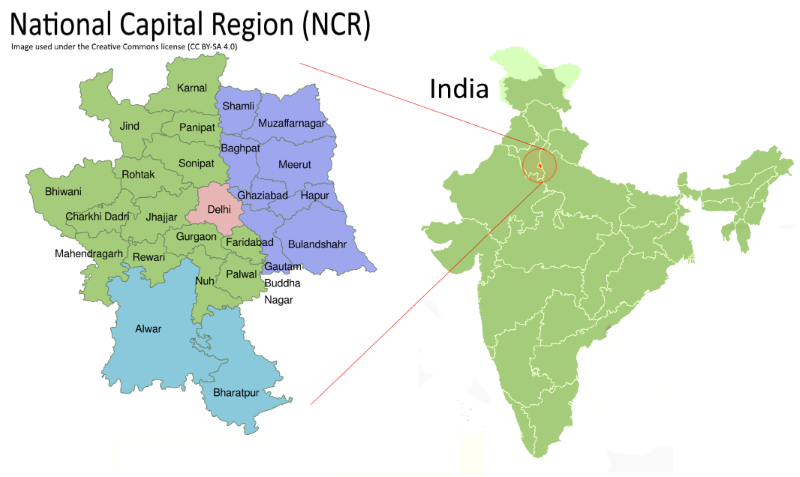Background
Introduction:
In 2016 it was estimated that there were approximately 1.5 million deaths across the Indian subcontinent that could be attributed to poor air quality (both ambient and household air quality)[1]. The Indian capital, Delhi, has, in recent years become synonymous with air pollution issues, with the World Health Organisation (WHO) citing the city as one of the worst major cities in the world[2]. Most of the air quality issues and episodes (as defined by the Indian Government or WHO) stem from excessive levels of particulate matter (PM10 and PM2.5) in the atmosphere.
The reasons for these high levels are manifold, being attributed to: the high levels of road transportation, industrial and construction activities, the burning of coal and pet coke for energy, domestic cooking practices and solid waste incineration within the city boundaries. In neighbouring regions, the operation of brick kilns, and the practice of agricultural stubble burning, also contribute to particulate levels in the capital. Other gaseous pollutants, such as oxides of nitrogen and sulfates, contribute to the formation of so-called ‘secondary’ particulates. Problems are exacerbated in the winter months (October-March) by unfavourable climatic conditions trapping pollutants at heights near the ground.
Against this backdrop in 2017, the city adopted the Graded Response Action Plan (GRAP)[3], which imposes varying levels of stringent controls across many sectors in the city, depending on current and forecast levels of pollution. Alongside the short-term response of the GRAP, longer-term measures have been implemented in the last decade, for example the conversion of public transport fleets to Compressed Natural Gas (CNG) operation, or the adoption of Liquid Petroleum Gas (LPG) for domestic cooking. The CADTIME project offers a complimentary, holistic approach to the development of intervention measures and mitigation strategies, by directly embedding stakeholder involvement at all levels of participation, from members of the general public, right through to governmental collaboration.
Study Area:
Whilst the primary focus of work is centred on the Delhi metropolitan area, it is recognised that air pollution knows no boundaries. CADTIME, and its sister APHH projects, are mindful that pollutants may be imported from the wider area around Delhi, including: various satellite cities (e.g. Gurugram, Noida, Faridabad etc.), adjacent states (Haryana, Uttar Pradesh and Rajasthan) and international neighbours (e.g. Pakistan, Afganistan). Likewise, successful intervention and mitigation measures may require a broader scope of action than in Delhi alone. Hence, for these reasons, CADTIME is looking towards solutions that encompass elements of the National Capital Region (NCR), as well as Delhi itself - see map below.

The National Capital Region is inhabited by approximately 46 million people (2011 Census), with 63% of its 55,000 km2 area urbanised, whilst Delhi itself (National Capital Territory of Delhi) is home to approximately 18 million people across 1,500 km2[4].
References:
[1] Global Burden of Disease 2016 – Data Visualisations. https://gbd2016.healthdata.org/gbd-compare/india.
[2] WHO Global Ambient Air Quality Database (update 2018) http://www.who.int/airpollution/data/cities/en/
[3] Graded Response Action Plan. http://envfor.nic.in/sites/default/files/Gazette%20Notification%20dated%2012.01.2017%20entrusting%20implimentation%20of%20Graded%20Response%20Action%20Plan%20to%20EPCA%20.pdf
[4] 2011 Census of India. https://en.wikipedia.org/wiki/2011_Census_of_India



